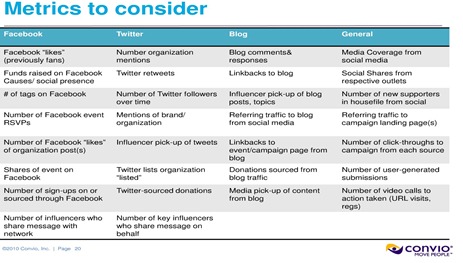Wednesday at DC Week featured three related, but distinct interpretations of measuring ROI when it comes to Social Media. First up was “Social Media ROI” as presented by Carie Lewis from the Humane Society, Danielle Brigida of the National Wildlife Federation and moderated by Allyson Kapin of the Rad Campaign.
As Carrie put it in a Tweet to Jordan, “@jordanv i’m thinking our #dcweek panel titles should have been switched!” This is correct. Although there was some good general strategic advice, this panel did not delve too deeply into ROI. (Carrie also deserves credit for replying to answering questions from the audience during her panel.) Overall, if you were looking for a basic strategic outline of how to manage social media for your organization, the Humane Society has a great model form which to start as well as several solid takeaways to do right now:
Strategy Takeaways
| Be where the (your) people are | Start by deciding on one network. Find your constituents and focus on building it |
|
| Stay on top of latest trends (Mashable) | Implement a tracking system. A fancy CMS is great, but Google Analytics will do. | |
| Research opportunities | Take advantage of Google Grants | |
| Take an integrated Approach | Set up Google and Tweetbeep Alerts | |
| Measure everything | Find Influencers. Consider offering Incentives | |
| Executive participation. (From your org.) | Replicate all Events on Facebook, Twitter. | |
| Listen (Actually this is the first step) | Use Addthis.com to make everything shareable | |
| No Fear to Fail. Learn from mistakes | Make social networking presence media driven: Flickr photos, videos, Great text alone isn’t enough! |
Second up was “Getting Strategic With Social Media” presented by Jordan Viator of Convio, Wendy Harman of the Red Cross and Jaime-Alexis Fowler of Pathfinder. If you are looking for an excellent outline of what to measure, Jordan’s presentation is highly recommended. However what was not included in her presentation, is for me what is the essence of ROI in social media is- What does it all mean? My point here is not that Jordan left anything out, but that each organization needs to assign their own custom values to the metrics outlined bellow. If your a locally focused non-profit, it is probably unrealistic to expect a lot of growth in your Twitter following or maybe even Facebook fans. In these cases, perhaps creating a custom Ning network to concentrate your supporters and focus their advocacy makes sense. Not every organization needs thousands of fans, followers or supporters to be successful.

The keynotes, by Cammie Croft, Senior Advisor and New Media Director at the Department of Energy and Charlene Li, Founder of Altimeter Group, co-author of the acclaimed book "Groundswell" and author of the new book "Open Leadership” both addressed ROI in social media from two different but complementary perspectives. One surprising fact mentioned by Cammie was that a major hurdle to embracing social media was first obtaining an exemption from the Paperwork Reduction Act, which prior to being amended by OMB, had the unintended consequence of discouraging agencies from using social media due to the act’s requirement that agencies normally have to obtain a control number from OMB on all forms that solicit information from the public and impose a paperwork burden. The progress of Open Government initiatives across government agencies is available on the White House’s website.
Addressing the topic of what ROI in Social Media means was Charlene Li, whose open source research at the Altimeter Group is a must read for anyone doing social media. What struck me the most, and generated a significant amount of Twitter traffic was her comment that the most important aspect of social media, namely the strength and quality of relationships may be impossible to calculate, because it is potentially infinite. For instance, can you put a number on the public’s faith in government? Can you measure the ROI of a handshake or the time spent attending a conference like Digital Capital Week? While some aspect of ROI in these cases may be quantifiable, the total value is essentially infinite, and therefore unquantifiable. Charlene’s discussion on these points begins around the 25 minute mark. Alexander Howard, the Government 2.0 Washington Correspondent of O’Reilly Media has an excellent article highlighting the best panels on technological innovation in D.C.
Sign up today to have our latest posts delivered straight to your inbox.